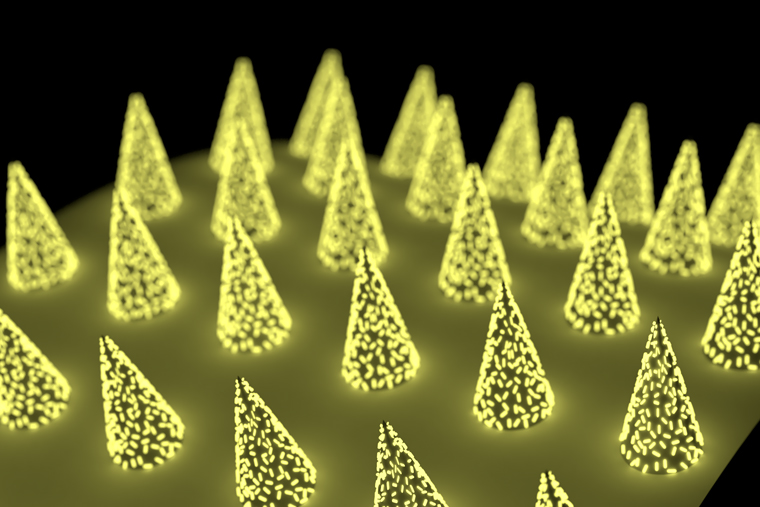Blood collection is not fun.
They hurt. The veins can burst or even roll – as if they were trying to avoid the needle too.
Doctors often use blood samples to check for disease biomarkers: antibodies that signal a viral or bacterial infection, such as SARS-CoV-2, the virus responsible for COVID-19, or cytokines indicative of inflammation seen in conditions such as rheumatoid arthritis. and sepsis.
These biomarkers are not just in the blood, however. They can also be found in the dense liquid medium that surrounds our cells, but in a low abundance that makes their detection difficult.
Yet.
 100vw, 300px “/><figcaption class=) Singamaneni
SingamaneniEngineers at the McKelvey School of Engineering at Washington University in St. Louis have developed a microneedle patch that can be applied to the skin, capture a biomarker of interest and, thanks to its unprecedented sensitivity, allow doctors to detect its presence.
The technology is inexpensive, easy to use by doctors or by the patients themselves and can eliminate the need for a trip to the hospital just for a blood collection.
The research, by Srikanth Singamaneni’s laboratory, Professor Lilyan & E. Lisle Hughes of the Department of Mechanical Engineering and Material Sciences, was published online January 22 in the journal Nature Biomedical Engineering.
In addition to the low cost and ease of use, these microneedle patches have another advantage over blood collection, perhaps the most important feature for some: “They are almost painless,” said Singamaneni.
Finding a biomarker using these microneedle patches is similar to blood testing. But instead of using a solution to find and quantify the biomarker in the blood, the microneedles capture it directly from the fluid that surrounds our cells in the skin, which is called dermal interstitial fluid (ISF). Once the biomarkers have been captured, they are detected in the same way – using fluorescence to indicate their presence and quantity.
ISF is a rich source of biomolecules, densely packed with everything from neurotransmitters to cellular waste. However, to analyze biomarkers in ISF, the conventional method usually requires ISF extraction from the skin. This method is difficult and generally the amount of ISF that can be obtained is not sufficient for the analysis. This has been a major obstacle to the development of microneedle-based biosensor technology.
Another method involves direct capture of the biomarker in ISF without having to extract ISF. Like going to a crowded show and trying to make your way ahead, the biomarker has to maneuver through a dynamic, crowded ISF soup before reaching the microneedle in the skin tissue. Under such conditions, being able to capture enough of the biomarker to see using the traditional assay is not easy.
But the team has a kind of secret weapon: “plasmonic fluors”, an ultrabright fluorescence nanolabel. In comparison to traditional fluorescent labels, when an assay was done on a microneedle patch using plasmonic fluorine, the signal from the target protein biomarkers glowed about 1,400 times brighter and became detectable even when present in low concentrations.
“Previously, the concentrations of a biomarker had to be on the order of a few micrograms per milliliter of fluid,” said Zheyu (Ryan) Wang, a graduate student in Singamaneni’s laboratory and one of the article’s main authors. This is well beyond the physiological range of the real world. But using plasmonic fluoride, the research team was able to detect biomarkers in the order of picograms per milliliter.
“This is more sensitive orders of magnitude,” said Wang.
These patches have a number of qualities that can have a real impact on medicine, patient care and research.
They would allow providers to monitor biomarkers over time, which is particularly important when it comes to understanding how immunity works in new diseases.
For example, researchers working with COVID-19 vaccines need to know whether people are making the right antibodies and for how long. “Let’s put a sticker on,” said Singamaneni, “and see if the person has antibodies against COVID-19 and at what level.”
Or, in an emergency, “When someone complains of chest pain and is being taken to the hospital in an ambulance, we hope that the patch can be applied immediately,” said Jingyi Luan, a recent graduate student at Singamaneni and a major authors of the article. Instead of having to get to the hospital and collect blood, paramedics can use a microneedle patch to test troponin, the biomarker that indicates myocardial infarction.
For people with chronic illnesses that require regular monitoring, microneedle patches can eliminate unnecessary hospital visits, saving money, time and discomfort – a lot of discomfort.
The adhesives are almost painless. “They penetrate about 400 microns into the dermal tissue,” said Singamaneni. “They don’t even touch the sensory nerves.”
In the laboratory, the use of this technology can limit the number of animals needed for research. Sometimes, research requires several measurements in succession to capture ebb and flow of biomarkers – for example, to monitor the progression of sepsis. Sometimes this means many small animals.
“We could significantly reduce the number of animals needed for these studies,” said Singamaneni.
The implications are vast – and Singamaneni’s laboratory wants to ensure that they are all explored.
There is a lot of work to be done, he said: “We will have to determine clinical cutoff points”, that is, the biomarker range in ISF that corresponds to a normal vs. normal level. not normal. “We will have to determine which levels of biomarker are normal, which levels are pathological.” And his research group is working on delivery methods for long distances and adverse conditions, offering options for improving rural health.
“But we don’t have to do all of this alone,” said Singamaneni. Instead, the technology will be available to specialists in different fields of medicine.
“We created a technology platform that anyone can use,” he said. “And they can use it to find their own biomarker of interest.”
